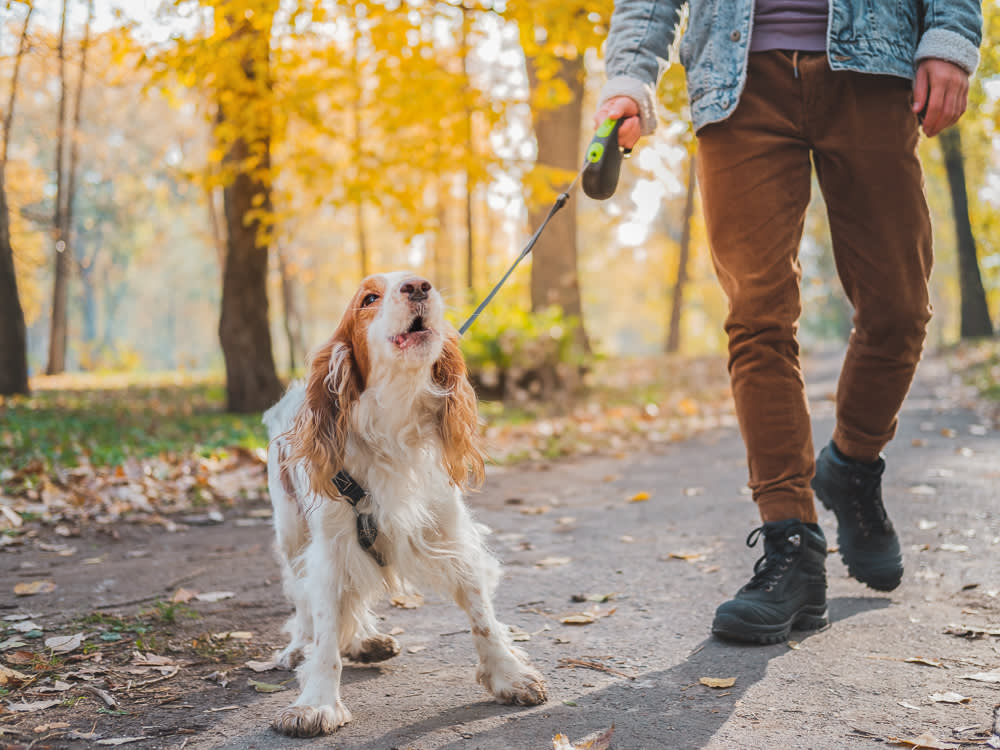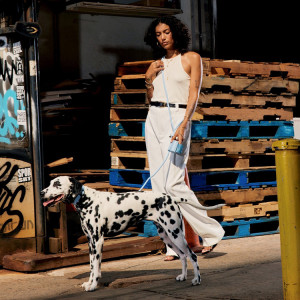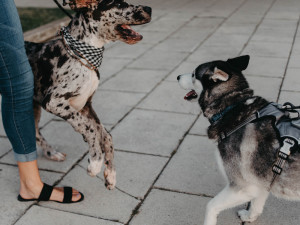Does Your Dog Act Diabolical On a Lead?
Same! Here’s how I got my pup to stop barking and lunging at everything that moves on walks

Share Article
I adopted my Lab mix Korra at eight weeks old and followed all of the training books to a T. I crate trained her, socialised her with all kinds of people, and brought her everywhere with me in the hopes that she would become an easy-going dog as she grew into adulthood. Those hopes were dashed when one day, on a walk in a new neighbourhood, an off-lead dog jumped a fence and raced towards us, teeth bared. We were able to get away without a scratch, but from then on, Korra’s behaviour changed. Seemingly overnight, she became uncontrollable, often lunging and barking at the end of her lead whenever she saw another dog. Walks became stressful for me, not enjoyable for her, and with each day, the behaviour only seemed to get worse. After a few months of this, I took her to a local trainer, who was able to give us a diagnosis for what was going on: lead reactivity.
What is lead reactivity?
Lead reactivity is when your dog overreacts to stimulus while they are on a lead. Dogs can be ‘reactive’ towards any trigger they have a negative association with, such as other dogs, cars or people. The reactivity could look like lunging, barking or growling. In some dogs, they may show a fearful response or try to run away from the thing that upsets them.
Where does this reactive behaviour come from? To understand reactivity, it’s first necessary to understand how a dog communicates. (Hint: it’s a lot different than how humans communicate.) Dogs prefer to give each other space, circle around each other, sniff bums and then maybe play – or, if they decide they don’t like each other, get out of each other’s faces. And what happens when you introduce a lead into the mix? Well, a lead essentially puts a dog in a cage – their movements are restricted and greetings often occur head-on, face-to-face. There are several reasons why a dog may not like this type of greeting.
It makes them feel protective
Some dogs get very sensitive or upset when a stranger (human or canine) comes close to their beloved owner.
It frustrates them
Some dogs get really excited by the prospect of saying hey to another dog – but, alas, the lead. The lead disrupts that greeting, which can frustrate your pup.
It makes them fearful
If a dog is fearful of the stimulus in front of them, the lead interrupts their biological ‘flight’ response, preventing them from escaping the thing that’s upsetting them – which can cause even more stress. This was the case for Korra. As soon as I understood she was reacting from a place of fear, I could move forward with tools to reduce that fear.
How to train a lead-reactive dog
There are multiple protocols out there, but they all boil down to one basic concept. The goal of lead reactivity training is to keep the dog below their threshold of frustration, so they can see the thing causing the reactivity without getting upset. You have to change their reaction to the negative stimulus – but you can only do that if you start the training a safe distance away from the trigger.
When I started out on this journey, this meant that the trigger-dog had to be at least on the other side of the street. At this point, Korra could see the dog and be aware of their presence, but she was assured that the dog wasn’t an immediate threat to her. Every time Korra looked at the dog without any signs of stress or reactivity, I would reward her with a treat. As soon as the dog disappeared from sight, the treats would stop. The idea is that, eventually, your dog will associate the sight of another dog with a happy event – getting a treat. And over time, your dog will be able to see another dog (or whatever their trigger) and react calmly, because they know that as soon as they do, good things happen.
An important note: don’t rush. Each dog will go at their own pace. If you see your dog reacting, exhibiting signs of stress or frustration, then you’ve moved too quickly and are expecting more from your dog than they can handle. Back off, and try again at a further distance.
Korra is still working on lowering her frustration when we’re on walks, but she has shown a world of improvement from the fearful, lunging reactive dog she used to be. It hasn’t been easy, but since we stuck with it, I have my walking buddy back.
PS: never use a retractable leadopens in new tab (like in the photo). They offer zero control and often jam, putting your pet (and any others within five metres) at risk.
Mari Shelafoe
Mari Shelafoe is a writer.
Related articles
![Three dogs on leashes meeting and sniffing each other on a walk on the summer grass with owners]()
How Do I Get My Shy Dog To Socialise?
Dog trainer Robert Haussmann’s tips for getting a shy pup to go from wallflower to social butterfly
![Dog walker walking with her pet on leash on the sidewalk]()
10 Tips You’ll Definitely Want to Follow When You Walk Your Dog
From the safest gear to training recommendations
![Afghan hound dog mid jump in an open grass field]()
Overexcited Dog? How to Calm A Dog Down
If your dog loses their sh*t over anything from a squirrel to a visitor, dog behaviourist Trish King has some tips
![Dog walker crossing a street with three dogs]()
How to Prepare Your Pup For Daycare and Dog Walkers
Set your pup up for success







